Anthrax case exposes flaws
- Share via
Criminal Minds
CBS, Wednesday, May 13, 2009, 9 p.m. Episode: “Amplification”
The premise
A man opens a vial of white powder in a public park, and the contents scatter in the wind. Hours later, those who were in the park begin to cough up blood and develop fevers. Twenty-five victims are hospitalized and 12 die within the first 24 hours. Tests confirm anthrax exposure, and Dr. Linda Kimua, chief of special pathogens at the federal Centers for Disease Control and Prevention, is brought in to help monitor and treat the cases. Members of the “Criminal Minds” team -- the FBI’s behavioral analysis unit, led by Aaron Hotchner (Thomas Gibson) -- take the antibiotic Cipro to protect against infection, though they aren’t sure whether it will work. Kimua reports that the odorless, invisible anthrax spores had been weaponized to attack deep in the lungs. The victims’ anthrax skin lesions are doubling in size, but Kimua is more worried about the inhalation cases.
“We don’t know how to combat the toxins once they’re inside,” she says. “The reality is, we may lose them all.”
Survivors are moved to a special wing at Walter Reed Hospital for isolation and further treatment. Kimua says the strain doubles in number every 30 to 45 minutes, causing massive lung hemorrhaging and organ failure. None of the antibiotic combinations are helping. Kimua notes that several of the patients who died had earlier become aphasic, losing the ability to comprehend others or to express themselves, as the toxin affected the parietal lobe of the brain. The team calls in Army Gen. Lee Whitworth, in charge of containment and anthrax spore analysis at Ft. Detrick in Frederick, Md., who helps them track the scientist who unleashed the attack.
Medical questions
Why is anthrax so deadly? Can weaponized anthrax work so rapidly “deep in the lungs” and not respond to antibiotics? Does prophylactic treatment of those who are in contact with it help prevent infection? Does the toxin produced by the spore affect the parietal lobe of the brain? Is there an experimental cure administered by inhalers, as the show suggests? Who would be in charge of an investigation of this kind?
The reality
Anthrax is a bacterium found in nature. Unlike many other kinds of bacteria, anthrax doesn’t move and is covered by a very tough capsule made of the protein poly-D-glutamic acid. It makes spores that are very small, 1 micron to 9 microns in diameter, and “perfectly packaged to enter the alveoli deep in the lung,” says Adm. Dr. Ali Khan, deputy director of the national center for zoonotic, vector-borne and enteric diseases at the CDC. Khan adds that only a few spores are needed to cause a human infection. Anthrax spores can also be weaponized into an inhalable powder, as was the case with the anthrax mailings of 2001.
Anthrax is very deadly because its capsule keeps it from being destroyed by our immune system -- engulfed by the white blood cells that protect us from infection. It also makes two powerful toxins: edema toxin and lethal toxin. If antibiotics aren’t given in time, the patient will likely die as a result of the toxins. But the show’s scenario of a very short incubation and rapid doubling time for the bacteria in the body is far-fetched, Khan says. According to the anthrax manual of the U.S. Army Medical Research Institute for infectious diseases, the incubation time between exposure and the first symptoms is one to six days, with death usually occurring within 24 to 36 hours after the onset of severe symptoms.
The antibiotics ciprofloxacin and doxycycline can be used as treatment or as a prophylaxis, though Khan points out that antibiotic resistance could be engineered. But Khan adds that patients would not have to be treated or contained at a single hospital, as the show suggests, because anthrax is not contagious.
The toxin produced by the spores can affect the brain and its covering (meninges) but wouldn’t specifically target the parietal lobe.
New experimental anti-toxins are being investigated, and according to Khan could be administered by inhalers as a rapid means of drug delivery. But anthrax mainly causes damage beyond the lungs, in the lymph nodes and around the body. “There is no such thing as a secret cure,” he says.
The FBI would be in charge of the criminal investigation involving anthrax exposure, as the show depicts, with the CDC working with state and local health departments for the local investigation and public health response. The Army’s Medical Research Institute for Infectious Diseases would not become involved except to test samples, possibly to provide consultation and later for internal investigation if one of their scientists was found to have been the source.
--
Siegel is an associate professor of medicine at New York University’s School of Medicine. marc@doctorsiegel.com
More to Read
Sign up for Essential California
The most important California stories and recommendations in your inbox every morning.
You may occasionally receive promotional content from the Los Angeles Times.













